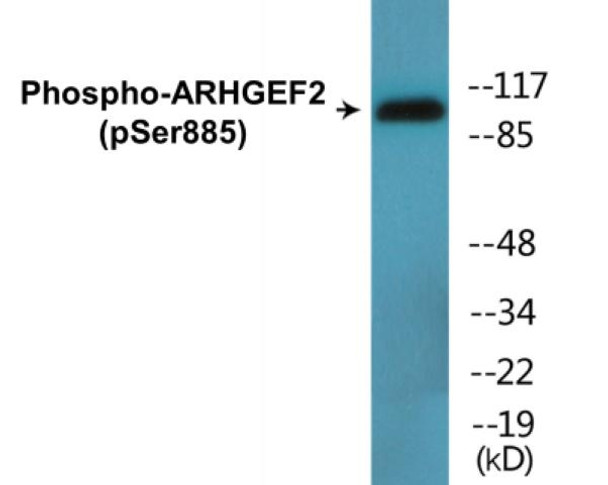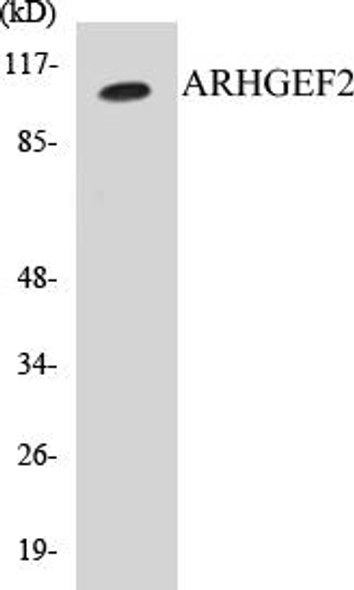Description
ARHGEF2 (Phospho-Ser885)Colorimetric Cell-Based ELISA Kit
The ARHGEF2 Phospho-Ser885 Colorimetric Cell-Based ELISA Kit offered by Assay Genie is a cutting-edge tool for the quantitative analysis of ARHGEF2 phosphorylation at serine 885 in cell lysates. This innovative kit allows researchers to accurately measure ARHGEF2 activity in a cell-based context, providing valuable insights into cell signaling pathways and potential therapeutic targets.ARHGEF2, also known as Rho/Rac Guanine Nucleotide Exchange Factor 2, plays a critical role in regulating Rho GTPase signaling, which is essential for cellular processes such as cytoskeleton reorganization, cell migration, and cell proliferation.
Phosphorylation of ARHGEF2 at serine 885 has been implicated in various diseases, including cancer and neurological disorders, making it a key target for drug development and disease research.The ARHGEF2 Phospho-Ser885 Colorimetric Cell-Based ELISA Kit offers superior sensitivity and specificity, enabling researchers to detect subtle changes in ARHGEF2 phosphorylation levels with confidence. With its user-friendly protocol and reliable performance, this kit is an indispensable tool for studying ARHGEF2-mediated signaling pathways and developing targeted therapies for a range of diseases.
| Product Name: | ARHGEF2 (Phospho-Ser885) Colorimetric Cell-Based ELISA |
| Product Code: | CBCAB01485 |
| ELISA Type: | Cell-Based |
| Target: | ARHGEF2 (Phospho-Ser885) |
| Reactivity: | Human, Mouse, Rat |
| Dynamic Range: | > 5000 Cells |
| Detection Method: | Colorimetric 450 nm |
| Format: | 2 x 96-Well Microplates |
The ARHGEF2 (Phospho-Ser885) Colorimetric Cell-Based ELISA Kit is a convenient, lysate-free, high throughput and sensitive assay kit that can detect ARHGEF2 protein phosphorylation and expression profile in cells. The kit can be used for measuring the relative amounts of phosphorylated ARHGEF2 in cultured cells as well as screening for the effects that various treatments, inhibitors (ie. siRNA or chemicals), or activators have on ARHGEF2 phosphorylation.
Qualitative determination of ARHGEF2 (Phospho-Ser885) concentration is achieved by an indirect ELISA format. In essence, ARHGEF2 (Phospho-Ser885) is captured by ARHGEF2 (Phospho-Ser885)-specific primary (1ø) antibodies while the HRP-conjugated secondary (2ø) antibodies bind the Fc region of the 1ø antibody. Through this binding, the HRP enzyme conjugated to the 2ø antibody can catalyze a colorimetric reaction upon substrate addition. Due to the qualitative nature of the Cell-Based ELISA, multiple normalization methods are needed:
| 1. | A monoclonal antibody specific for human GAPDH is included to serve as an internal positive control in normalizing the target absorbance values. |
| 2. | Following the colorimetric measurement of HRP activity via substrate addition, the Crystal Violet whole-cell staining method may be used to determine cell density. After staining, the results can be analysed by normalizing the absorbance values to cell amounts, by which the plating difference can be adjusted. |
| Database Information: | Gene ID: 9181, UniProt ID: Q92974, OMIM: 607560, Unigene: Hs.655209 |
| Gene Symbol: | ARHGEF2 |
| Sub Type: | Phospho |
| UniProt Protein Function: | ARHGEF2: a microtubule-associated guanine nucleotide exchange factor for Rac and Rho GTPases. Mediates cross-talk between microtubules and the actin cytoskeleton. Contains a phorbol esters/diacylglycerol binding and PH domain. |
| UniProt Protein Details: | Protein type:Motility/polarity/chemotaxis; GEFs, Rac/Rho; GEFs Chromosomal Location of Human Ortholog: 1q21-q22 Cellular Component: cell soma; cytoplasm; cytoplasmic membrane-bound vesicle; cytoskeleton; cytosol; dendritic shaft; focal adhesion; Golgi apparatus; microtubule; protein complex; spindle; tight junction; vesicle Molecular Function:microtubule binding; protein binding; Rac GTPase binding; Rac guanyl-nucleotide exchange factor activity; Rho GTPase binding; Rho guanyl-nucleotide exchange factor activity; transcription factor binding; zinc ion binding Biological Process: actin filament organization; activation of NF-kappaB transcription factor; cell division; cell morphogenesis; establishment of mitotic spindle orientation; innate immune response; intracellular protein transport; mitosis; negative regulation of microtubule depolymerization; negative regulation of neurogenesis; nerve growth factor receptor signaling pathway; positive regulation of apoptosis; positive regulation of GTPase activity; positive regulation of interleukin-6 production; positive regulation of peptidyl-tyrosine phosphorylation; positive regulation of transcription from RNA polymerase II promoter; positive regulation of tumor necrosis factor production; regulation of cell proliferation; regulation of Rho protein signal transduction; regulation of small GTPase mediated signal transduction; small GTPase mediated signal transduction |
| NCBI Summary: | Rho GTPases play a fundamental role in numerous cellular processes that are initiated by extracellular stimuli that work through G protein coupled receptors. The encoded protein may form complex with G proteins and stimulate rho-dependent signals. Alternatively spliced transcript variants encoding different isoforms have been identified.[provided by RefSeq, Jun 2009] |
| UniProt Code: | Q92974 |
| NCBI GenInfo Identifier: | 205830906 |
| NCBI Gene ID: | 9181 |
| NCBI Accession: | Q92974.4 |
| UniProt Secondary Accession: | Q92974,O75142, Q15079, Q5VY92, Q8TDA3, Q8WUG4, Q9H023 D3DVA6, |
| UniProt Related Accession: | Q92974 |
| Molecular Weight: | 108,242 Da |
| NCBI Full Name: | Rho guanine nucleotide exchange factor 2 |
| NCBI Synonym Full Names: | Rho/Rac guanine nucleotide exchange factor 2 |
| NCBI Official Symbol: | ARHGEF2 |
| NCBI Official Synonym Symbols: | GEF; P40; GEFH1; LFP40; GEF-H1 |
| NCBI Protein Information: | rho guanine nucleotide exchange factor 2 |
| UniProt Protein Name: | Rho guanine nucleotide exchange factor 2 |
| UniProt Synonym Protein Names: | Guanine nucleotide exchange factor H1; GEF-H1; Microtubule-regulated Rho-GEF; Proliferating cell nucleolar antigen p40 |
| Protein Family: | Rho guanine nucleotide exchange factor |
| UniProt Gene Name: | ARHGEF2 |
| UniProt Entry Name: | ARHG2_HUMAN |
| Component | Quantity |
| 96-Well Cell Culture Clear-Bottom Microplate | 2 plates |
| 10X TBS | 24 mL |
| Quenching Buffer | 24 mL |
| Blocking Buffer | 50 mL |
| 15X Wash Buffer | 50 mL |
| Primary Antibody Diluent | 12 mL |
| 100x Anti-Phospho Target Antibody | 60 µL |
| 100x Anti-Target Antibody | 60 µL |
| Anti-GAPDH Antibody | 60 µL |
| HRP-Conjugated Anti-Rabbit IgG Antibody | 12 mL |
| HRP-Conjugated Anti-Mouse IgG Antibody | 12 mL |
| SDS Solution | 12 mL |
| Stop Solution | 24 mL |
| Ready-to-Use Substrate | 12 mL |
| Crystal Violet Solution | 12 mL |
| Adhesive Plate Seals | 2 seals |
The following materials and/or equipment are NOT provided in this kit but are necessary to successfully conduct the experiment:
- Microplate reader able to measure absorbance at 450 nm and/or 595 nm for Crystal Violet Cell Staining (Optional)
- Micropipettes with capability of measuring volumes ranging from 1 µL to 1 ml
- 37% formaldehyde (Sigma Cat# F-8775) or formaldehyde from other sources
- Squirt bottle, manifold dispenser, multichannel pipette reservoir or automated microplate washer
- Graph paper or computer software capable of generating or displaying logarithmic functions
- Absorbent papers or vacuum aspirator
- Test tubes or microfuge tubes capable of storing ≥1 ml
- Poly-L-Lysine (Sigma Cat# P4832 for suspension cells)
- Orbital shaker (optional)
- Deionized or sterile water
*Note: Protocols are specific to each batch/lot. For the correct instructions please follow the protocol included in your kit.
| Step | Procedure |
| 1. | Seed 200 µL of 20,000 adherent cells in culture medium in each well of a 96-well plate. The plates included in the kit are sterile and treated for cell culture. For suspension cells and loosely attached cells, coat the plates with 100 µL of 10 µg/ml Poly-L-Lysine (not included) to each well of a 96-well plate for 30 minutes at 37 °C prior to adding cells. |
| 2. | Incubate the cells for overnight at 37 °C, 5% CO2. |
| 3. | Treat the cells as desired. |
| 4. | Remove the cell culture medium and rinse with 200 µL of 1x TBS, twice. |
| 5. | Fix the cells by incubating with 100 µL of Fixing Solution for 20 minutes at room temperature. The 4% formaldehyde is used for adherent cells and 8% formaldehyde is used for suspension cells and loosely attached cells. |
| 6. | Remove the Fixing Solution and wash the plate 3 times with 200 µL 1x Wash Buffer for five minutes each time with gentle shaking on the orbital shaker. The plate can be stored at 4 °C for a week. |
| 7. | Add 100 µL of Quenching Buffer and incubate for 20 minutes at room temperature. |
| 8. | Wash the plate 3 times with 1x Wash Buffer for 5 minutes each time. |
| 9. | Add 200 µL of Blocking Buffer and incubate for 1 hour at room temperature. |
| 10. | Wash 3 times with 200 µL of 1x Wash Buffer for 5 minutes each time. |
| 11. | Add 50 µL of 1x primary antibodies Anti-ARHGEF2 (Phospho-Ser885) Antibody, Anti-ARHGEF2 Antibody and/or Anti-GAPDH Antibody) to the corresponding wells, cover with Parafilm and incubate for 16 hours (overnight) at 4 °C. If the target expression is known to be high, incubate for 2 hours at room temperature. |
| 12. | Wash 3 times with 200 µL of 1x Wash Buffer for 5 minutes each time. |
| 13. | Add 50 µL of 1x secondary antibodies (HRP-Conjugated AntiRabbit IgG Antibody or HRP-Conjugated Anti-Mouse IgG Antibody) to corresponding wells and incubate for 1.5 hours at room temperature. |
| 14. | Wash 3 times with 200 µL of 1x Wash Buffer for 5 minutes each time. |
| 15. | Add 50 µL of Ready-to-Use Substrate to each well and incubate for 30 minutes at room temperature in the dark. |
| 16. | Add 50 µL of Stop Solution to each well and read OD at 450 nm immediately using the microplate reader. |
(Additional Crystal Violet staining may be performed if desired – details of this may be found in the kit technical manual.)






